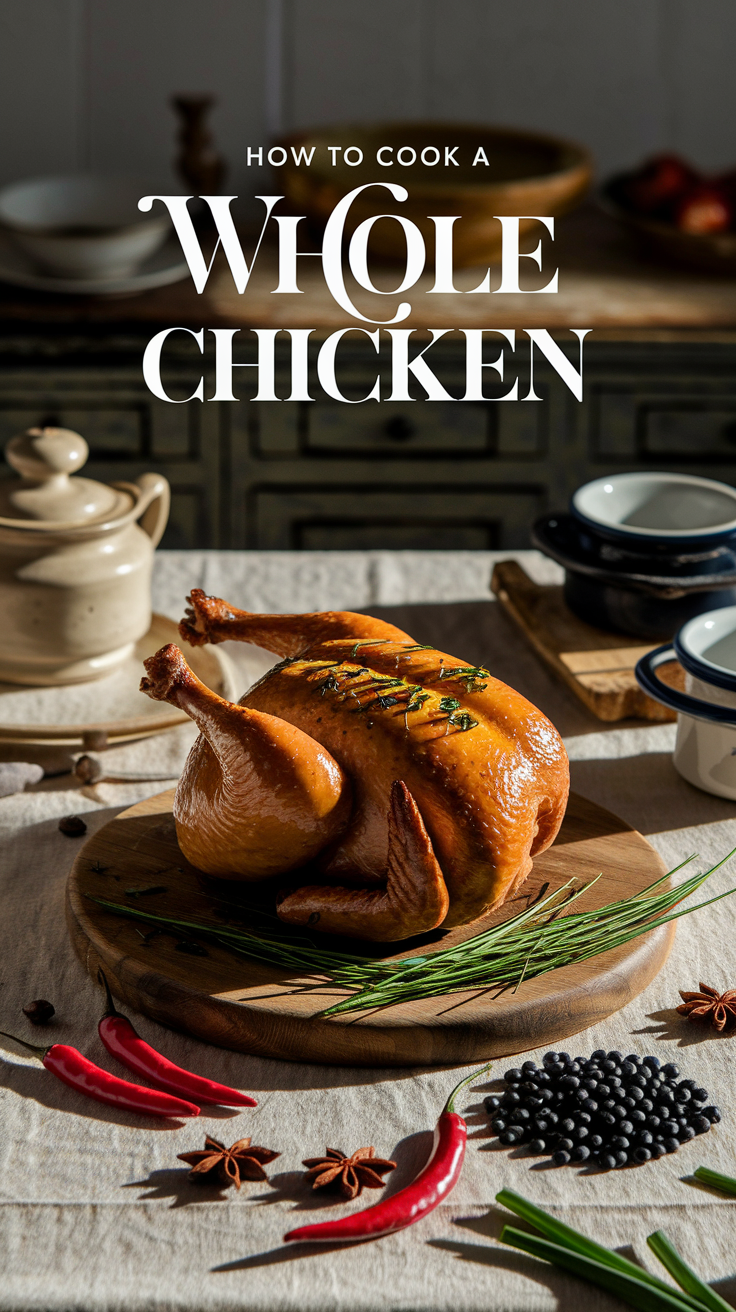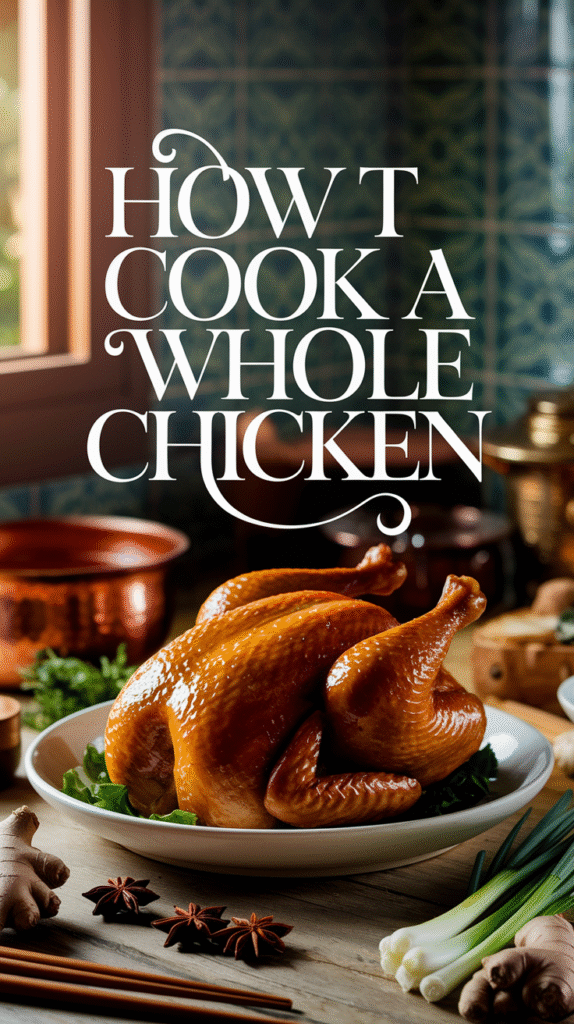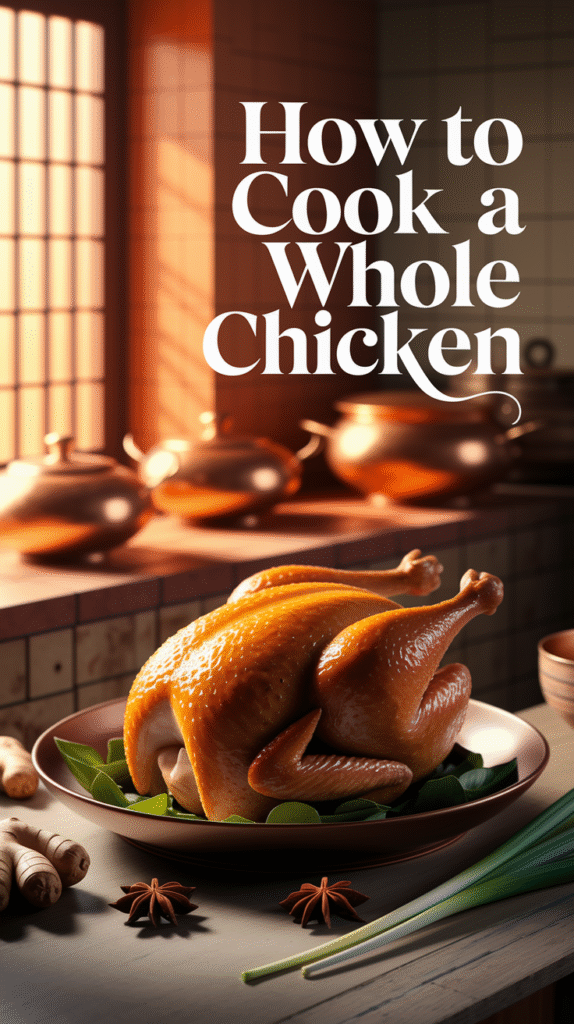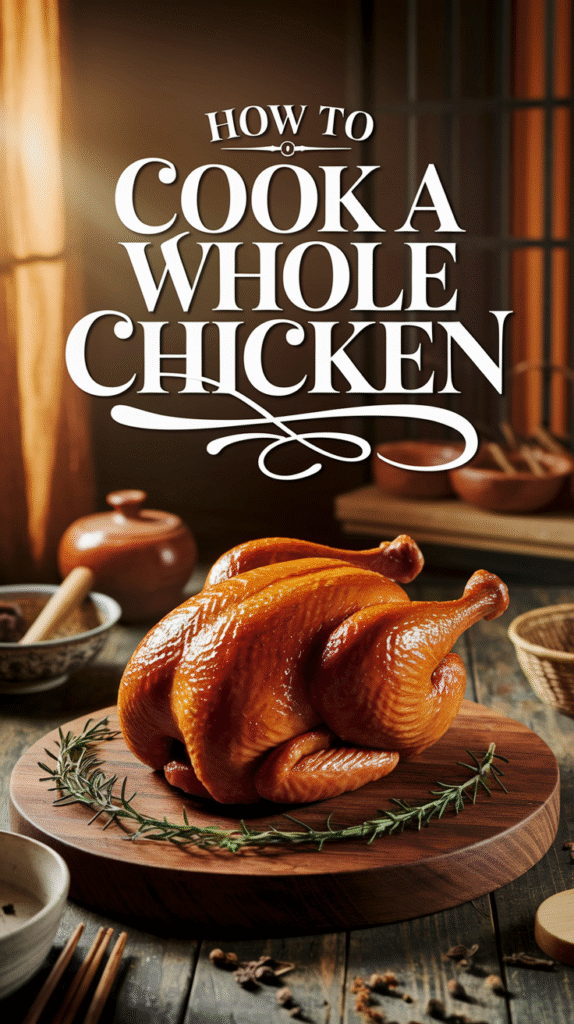Cooking a whole chicken can seem daunting, but with the right techniques and tips, you can easily master this skill and create a flavorful dish that impresses everyone. Whether you’re roasting, grilling, or slow-cooking, understanding the basics will help you produce a juicy and tender chicken. Let’s explore the best methods to cook a whole chicken.
Choosing the Right Chicken
When selecting a whole chicken, consider its size and quality. Visit your local butcher or grocery store to find one that is fresh and preferably organic. Look for a chicken that has:
- Even, golden skin
- No bruising or discoloration
- A pleasant, fresh smell
Preparation Techniques
Preparing your chicken properly is crucial for great results. Before cooking, make sure to:
- Clean your working area and utensils.
- Remove any giblets from the cavity.
- Rinse the chicken under cold water and pat it dry with paper towels.
Dry skin is essential for achieving crispy skin, so make sure to eliminate any moisture. Next, season your chicken generously, inside and out, with salt and pepper. This enhances the flavor and helps to tenderize the meat.
Cooking Methods
There are various methods to cook a whole chicken, and each offers unique flavors and textures. Here are three popular techniques:
Roasting
Roasting a chicken in the oven is perhaps the most common method. It creates a delicious, golden skin while keeping the meat moist.
- Preheat your oven to 425°F (220°C).
- Place the chicken in a roasting pan, breast side up.
- Add vegetables such as carrots, potatoes, and onions around the chicken for extra flavor.
- Roast for about 1 hour and 15 minutes, or until the internal temperature reaches 165°F (75°C).
- Let it rest for about 10-15 minutes before carving.
Grilling
Grilling a whole chicken adds a smoky flavor that is hard to beat. To ensure even cooking, consider spatchcocking (removing the backbone) your chicken.
- Preheat your grill to medium heat.
- Flatten the chicken by pressing down on the breast.
- Season the chicken and place it on the grill, skin side down.
- Cook for about 45 minutes, flipping halfway through, until it reaches the desired temperature.
Slow Cooking
If you prefer a hands-off approach, using a slow cooker is an excellent option. The chicken will become incredibly tender and full of flavor.
- Season the chicken and place it in the slow cooker.
- Add broth, herbs, and vegetables if desired.
- Cook on low for 6-8 hours or on high for 4-5 hours.
Flavor Enhancements
To elevate the taste of your chicken, consider the following:
- Marinate: Use a marinade of oil, vinegar, herbs, and spices for a few hours or overnight.
- Add aromatics: Stuff the cavity with garlic, lemon, or fresh herbs for extra flavor.
- Use butter: Spreading butter under the skin helps keep the meat moist and adds flavor.
Serving Your Chicken
Once your chicken is cooked, let it rest to allow the juices to redistribute. Carve and serve alongside your favorite sides for a complete meal. Don’t forget to save the carcass for homemade chicken broth!
Resources
To further enhance your chicken-cooking skills, explore these resources:
With these techniques and tips, you’re well on your way to mastering the art of cooking a whole chicken. Experiment with different methods and flavors to find your perfect recipe!
Flavor Profiles: Best Seasonings for Whole Chicken Preparation
When it comes to cooking a whole chicken, the seasonings you choose can elevate the dish to a savory delight. Flavor profiles are essential for creating a bird that’s juicy, tender, and aromatic. Whether you prefer classic herbs or bold spices, let’s explore some of the best seasonings that will make your whole chicken memorable.
Classic Herb Combinations
Herbs bring a fresh taste to the table. Here are some timeless combinations:
- Rosemary and Thyme: These herbs pair beautifully. They impart a fragrant, earthy flavor that complements chicken perfectly.
- Sage and Parsley: This combination adds a slight peppery bite that works well with roasted chicken.
- Oregano and Basil: Great for a Mediterranean flair, these herbs bring sweetness and a hint of warmth.
Spicy Sensations
If you enjoy heat, consider these seasonings:
- Cayenne Pepper: A little goes a long way. It adds a lively kick to your chicken.
- Chili Powder: This blend typically includes various spices, providing a rich depth with just the right amount of heat.
- Smoked Paprika: This seasoning gives a smoky flavor while adding vibrant color to the skin of your chicken.
Global Inspired Blends
For a taste of international cuisine, try these unique blends:
- Chinese Five Spice: This aromatic blend includes star anise, cloves, Chinese cinnamon, Sichuan pepper, and fennel seeds. It’s perfect for a different take on roasted chicken.
- Indian Garam Masala: A mixture of spices like cardamom, cumin, and coriander, this blend offers warmth and depth.
- Southwest Spice Mix: Featuring ingredients like cumin, coriander, and a bit of chili powder, this blend brings a zesty touch.
Citrus Zest and Flavors
Citrus adds brightness to your whole chicken, enhancing its natural flavors. Here are some citrus options to consider:
- Lemon Zest: Adds a refreshing zing that cuts through the richness of the chicken.
- Orange Juice and Zest: Gives a sweeter profile that pairs beautifully with herbs like thyme and rosemary.
- Lime Juice: Adds a sharp acidity that complements spices well, especially in grilled or roasted dishes.
Fabulous Marinades
A marinade can infuse deeper flavors into your chicken before it hits the oven. Consider these recipes:
| Marinade | Key Ingredients |
|---|---|
| Lemon Herb | Lemon juice, garlic, rosemary, thyme, olive oil |
| Asian Soy | Soy sauce, honey, garlic, ginger, sesame oil |
| Tandoori | Yogurt, tandoori spice mix, garlic, lemon juice |
Seasoning Tips for Best Results
To maximize the flavor of your chicken:
- Season Generously: Don’t be shy with herbs and spices. Generous seasoning helps enhance the natural flavors of the chicken.
- Use a Dry Rub: A dry rub can create a flavorful crust. Apply it at least an hour before cooking, or ideally, overnight.
- Don’t Forget the Inside: Season inside the cavity as well. Adding lemon halves, garlic cloves, or herbs inside boosts flavor.
By varying the herbs and spices, you can create endless possibilities for your whole chicken. Not only can you explore different regional flavors, but you can also adjust the seasoning to suit your taste preferences. Experiment, have fun, and enjoy the wonderful world of flavor profiles that come with cooking a whole chicken.
For more tips on seasoning and cooking techniques, check out Serious Eats or Food Network.
Cooking Methods: Comparing Roasting, Grilling, and Slow Cooking
Cooking is an art, and choosing the right method can elevate your culinary creations. Three popular methods of cooking are roasting, grilling, and slow cooking. Each method has its own unique benefits and can impart different flavors and textures to your food. Let’s delve into each technique to help you decide which one suits your needs best.
Roasting
Roasting is a dry cooking method that exposes food to direct, even heat in an oven. It typically involves cooking larger cuts of meat, such as whole chickens or briskets, at high temperatures. This method can create delicious brown crusts while keeping the insides juicy and flavorful. Here’s a quick list of the pros and cons of roasting:
- Pros:
- Develops a rich flavor and appealing texture.
- Creates natural drippings, ideal for gravies and sauces.
- Hands-off cooking after initial preparation.
- Cons:
- Takes longer compared to other methods.
- Can dry out meats if overcooked.
- Requires preheating oven, which can be energy-consuming.
Grilling
Grilling involves cooking food over direct heat, usually on a griddle or an open flame. It’s a popular method for cooking meats, vegetables, and even fruits. The intense heat quickly sears the outside, sealing in juices and enhancing flavors with a smoky char. Let’s examine the advantages and disadvantages of grilling:
- Pros:
- Fast cooking times; ideal for busy weeknights.
- Impacts a unique smoky flavor, especially when using wood or charcoal.
- Perfect for outdoor gatherings, creating a lively atmosphere.
- Cons:
- Requires constant attention to avoid burning.
- Can lead to uneven cooking without proper technique.
- Weather-dependent for outdoor grilling.
Slow Cooking
Slow cooking is a low and slow method that allows food to cook gradually over several hours in a crockpot or slow cooker. It’s especially beneficial for tougher cuts of meat that require prolonged cooking to become tender. Below are the key pros and cons of slow cooking:
- Pros:
- Great for meal prep; you set it and forget it.
- Tenderizes tough cuts of meat effectively.
- Allows flavors to meld beautifully over time.
- Cons:
- Long cooking time, which is not suited for last-minute meals.
- Lacks the crispy texture that some methods achieve.
- Requires pre-planning for ingredients and cooking time.
When to Use Each Method
The choice between roasting, grilling, and slow cooking often depends on the ingredients, time available, and the flavors you wish to achieve. Here are some recommendations:
| Cooking Method | Best For | Ideal Ingredients |
|---|---|---|
| Roasting | Hearty family meals | Whole meats, root vegetables |
| Grilling | Quick weekday dinners | Steaks, fish, vegetables, fruits |
| Slow Cooking | Making stews or sauces | Tough cuts of meat, legumes, soups |
Each cooking method has its charm and can significantly influence the final outcome of your dishes. Whether you want the rich flavors from roasting, the quick convenience of grilling, or the depth from slow cooking, mastering these techniques will broaden your culinary repertoire. For more tips on cooking methods, check out Food Network and Serious Eats.
Side Dishes That Pair Perfectly with Whole Chicken
Cooking a whole chicken is a delightful way to create a meal that feels both festive and comforting. The versatility of a whole roasted chicken means it pairs wonderfully with a variety of side dishes. Here are some fantastic options to consider that will enhance your chicken dish and please your guests.
Classic Vegetable Sides
Vegetables are a staple when it comes to pairing with whole chicken. Here are some favorites:
- Roasted Vegetables: Toss seasonal vegetables like carrots, potatoes, and bell peppers with olive oil, salt, and herbs. Roast them in the oven alongside your chicken for a delicious, caramelized flavor.
- Green Beans: Sauté fresh green beans in garlic and olive oil for a quick, bright side that complements the rich flavors of the chicken.
- Brussels Sprouts: Roasted Brussels sprouts with balsamic glaze add a sweet and savory contrast.
Starches to Fill You Up
Adding a starch can make your meal more filling. Consider these options:
- Potatoes: Mashed, roasted, or even baked potatoes can serve as a hearty companion. Creamy mashed potatoes topped with gravy are a classic pairing.
- Rice: Fluffy rice, either plain or flavored with herbs and spices, acts as a perfect canvas to soak up the chicken’s juices.
- Quinoa: For a healthier option, quinoa is packed with protein and pairs well with roasted vegetables.
Salads for Freshness
A salad can add a refreshing crunch to your meal, balancing the richness of the chicken. Try these options:
- Caesar Salad: Crisp romaine lettuce topped with Parmesan cheese, croutons, and Caesar dressing makes for a classic pairing.
- Cucumber Salad: A simple cucumber salad with vinegar, dill, and mint offers a refreshing bite.
- Greek Salad: Chopped cucumbers, tomatoes, olives, and feta cheese drizzled with olive oil makes for a vibrant and flavorful addition.
Delicious Breads
Bread is a comforting and versatile side dish. Consider these types:
- Crusty Baguette: Perfect for soaking up the delicious juices from the chicken.
- Garlic Bread: A crowd-pleaser, garlic bread is always a great addition to a hearty meal.
- Homemade Biscuits: Fluffy, buttery biscuits can be a delightful addition. They offer a lovely texture and flavor contrast.
Sauces and Dips
Enhancing your chicken with a sauce can elevate the dish further:
- Gravy: A rich, homemade gravy made from the chicken drippings will take your dish to another level.
- Chimichurri: This fresh herb sauce adds a zesty kick that pairs wonderfully with roasted meats.
- Honey Mustard: A sweet and tangy sauce can complement the savory aspects of your chicken.
Sweet Options
Don’t forget about sweet side dishes. They can provide a nice balance to the savory flavors:
- Roasted Sweet Potatoes: Naturally sweet and comforting, these can be seasoned with cinnamon or garlic for added flavor.
- Apple Sauce: A classic pairing that brings a sweet and tart element to the plate.
- Fruit Salad: A colorful fruit salad can brighten your meal and provide a refreshing counterpoint.
With these delicious side dish options, you can create a well-rounded meal centered around your perfectly cooked whole chicken. Each side complements the chicken’s flavor while adding variety and nutrition to your dinner table. Whether you’re cooking for a special occasion or a family dinner, these choices will impress.
If you want to learn more about cooking techniques or explore specific recipes and meal ideas, you might find Food Network or Bon Appétit to be helpful resources for inspiration.
Food Safety: Proper Handling and Cooking Temperatures for Chicken
When it comes to cooking chicken, knowing how to handle and prepare it safely is crucial. This delicious and versatile protein source can lead to serious health issues if not treated properly. Understanding the importance of food safety guidelines as well as appropriate cooking temperatures is essential to enjoy your chicken meals without the risk of foodborne illness.
Understanding Food Safety Basics
Food safety needs to be a priority in every kitchen. Here are some basic concepts that can help you manage chicken safely:
- Cleanliness: Always wash your hands, surfaces, and utensils before and after handling raw chicken to avoid cross-contamination.
- Separation: Keep raw chicken separate from other foods, especially those that won’t be cooked further, like salads or ready-to-eat meals.
- Storage: Store chicken in the refrigerator at or below 40°F (4°C). If you’re not using it within 1-2 days, consider freezing it at 0°F (-18°C) to maintain its quality.
Marinating Chicken Safely
If you’re marinating your chicken to enhance flavor, do it in the refrigerator, not at room temperature. Always discard any marinade that has come into contact with raw chicken to prevent bacteria from spreading.
Cooking Temperatures
The most critical aspect of cooking chicken is ensuring it reaches the right internal temperature. Chicken must be cooked to at least 165°F (75°C) to kill harmful bacteria like Salmonella and Campylobacter.
The following table provides a quick reference for safe cooking temperatures for various chicken parts:
| Type of Chicken | Recommended Internal Temperature (°F) |
|---|---|
| Whole Chicken | 165°F (75°C) |
| Chicken Breasts | 165°F (75°C) |
| Chicken Thighs | 175°F (80°C) |
| Chicken Wings | 165°F (75°C) |
| Ground Chicken | 165°F (75°C) |
To check the internal temperature accurately, use a food thermometer inserted into the thickest part of the meat, avoiding the bone. Let the chicken rest for a few minutes after cooking, as this allows the juices to redistribute and helps avoid dryness.
Thawing Chicken Safely
If you have frozen chicken, it’s essential to thaw it safely to prevent bacterial growth. Here are three safe methods to thaw chicken:
- Refrigerator Thawing: Plan ahead and place the chicken in the refrigerator for several hours or overnight.
- Cold Water Thawing: Seal the chicken in a leak-proof bag and submerge it in cold water, changing the water every 30 minutes.
- Microwave Thawing: Use the defrost function on your microwave, but cook the chicken immediately thereafter.
Storing Leftover Chicken
If you have leftover cooked chicken, store it in airtight containers in the refrigerator. It’s best to consume leftovers within 3 to 4 days. Ensure your fridge is set at or below 40°F (4°C) and reheat leftovers to 165°F (75°C) before eating.
Avoiding Common Mistakes
Many people make simple mistakes that could jeopardize food safety. Here are top errors to avoid:
- Not checking the internal temperature of cooked chicken.
- Thawing chicken on the counter, which can allow bacteria to thrive.
- Using the same cutting board for raw chicken and fresh vegetables.
Understanding and implementing these food safety practices will not only keep you and your family safe but also enhance your cooking experience. For more detailed information, you can visit the USDA Food Safety and Inspection Service and the CDC Food Safety webpage.
Make responsible cooking choices, and you’ll enjoy delicious and safe chicken meals without any worries. The more you know about food safety, the better your culinary adventures will be!
Conclusion
Cooking a whole chicken can be an incredibly rewarding experience that delivers both delicious results and a sense of achievement. By mastering various techniques and tips, you can elevate your culinary skills and impress friends and family with your cooking prowess. The right flavor profiles and seasonings can transform your chicken from simple to spectacular, allowing you to personalize the dish to suit your taste preferences.
Exploring different cooking methods such as roasting, grilling, or slow cooking adds versatility to your kitchen repertoire. Each method offers unique textures and flavors, ensuring that you can find the perfect approach for any occasion. Pairing your beautifully cooked chicken with complementary side dishes can complete the meal and create a harmonious dining experience. Options like roasted vegetables, creamy mashed potatoes, or a fresh salad can enhance the overall flavor and presentation.
Never underestimate the importance of food safety when cooking chicken. Proper handling and awareness of cooking temperatures are essential to prevent foodborne illnesses, ensuring that your meal is not only delicious but also safe to enjoy.
With the right techniques, seasonings, and an understanding of food safety, you can confidently prepare a whole chicken that will be the star of any dinner table. Embrace the journey of cooking a whole chicken, and let your culinary creativity shine. Enjoy the process, savor the aromas, and relish in the delicious results!







Leave a Reply